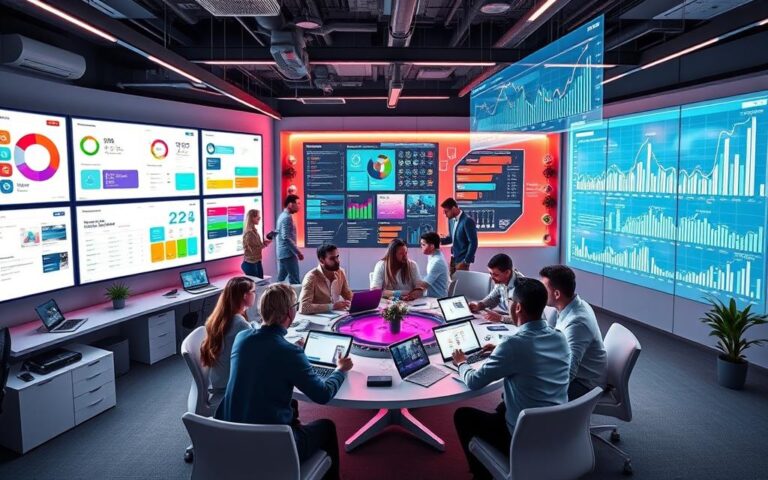Real-time Bidding and Programmatic Advertising Explained
Did you know that in 2021, programmatic advertising made up about 89% of all digital ad spending? By 2023, this number jumped to $546 billion, and it’s expected to hit $725 billion by 2026. This shows how fast digital marketing is changing. It’s important for marketers and advertisers to understand Real-time Bidding (RTB) and programmatic advertising to stay ahead.
RTB is about buying and selling digital ad space right away through auctions. Programmatic advertising, on the other hand, is about automated ad buying across different platforms. Knowing how these work can change how campaigns are run and how results are measured.
Key Takeaways
- Programmatic advertising is a big part of digital marketing spending.
- Real-time Bidding helps target ads better and save money.
- Demand-side platforms are key in managing ad bids and placements.
- The auction in RTB lets advertisers compete for spots in real time.
- Programmatic methods like private marketplaces give more control.
- Knowing the difference between RTB and programmatic advertising is crucial for success.
Understanding Programmatic Advertising
Programmatic Advertising changes the game in digital ads by automating the ad buying and selling process. It moves away from old-school negotiations and manual ad placements. With smart algorithms and AI, ads can be bought and sold in real-time, optimizing for many factors.
Programmatic ads are also more affordable. Direct buys can cost around $10 per thousand impressions. But, programmatic ads average between $0.50 and $2. This makes it easier to reach more people on different platforms like Google, social media, and TV.
One big plus is the ability to target specific audiences with great precision. Advertisers use data on demographics, behavior, and location to find the right customers. This targeted approach boosts campaign performance, allowing for quick adjustments after launch.
Also, programmatic ads are great for businesses of all sizes, especially those with small budgets. It saves time and reduces mistakes in the ad buying process. This makes it a top choice in digital marketing. Advances in technology are also opening up new areas like audio and TV for programmatic ads.
What is Real-time Bidding?
Real-time Bidding (RTB) is a big step forward in online ads. It lets advertisers buy ad space in quick auctions. These auctions happen in a split second when someone visits a website.
Ad exchanges share user info with advertisers. This leads to a bidding war for the ad spot. The highest bidder gets to show their ad right away.
This system is fast and cuts down on the hassle of old-school ads. Advertisers pay for every 1,000 views (CPM). This makes their ad spending more efficient.
RTB gives advertisers more control over who sees their ads. They can target specific groups better. This means less waste and less chance of fake views.
Publishers also win, getting more ads and making more money. A cool fact is that over 2 billion auctions happen every day. This shows how big and effective RTB is.
RTB also lets advertisers change their ads quickly. They can update visuals and messages fast. This helps ads work better for the audience.
RTB is key in today’s online ads. With digital ad spending growing, knowing RTB is vital. It helps advertisers stay ahead.
To learn more about AI in marketing, check out this informative piece.
The Relationship Between RTB and Programmatic Advertising
Real-Time Bidding (RTB) is a key part of Programmatic Advertising. RTB uses a dynamic auction to buy ad space in real time. Programmatic Advertising, on the other hand, includes different ways to buy media, like RTB and Programmatic Direct.
The digital ad market is growing fast, expected to hit $946.9 billion by 2027. This growth highlights the need to understand RTB and Programmatic Advertising. Advertisers can use RTB for quick bids, especially in open exchanges or private marketplaces. This helps target specific audiences well, making campaigns more effective.
Programmatic Direct is different, focusing on guaranteed ad space and set prices. It uses automation to make buying ads easier, unlike old methods. Both RTB and Programmatic Direct offer choices for advertisers to reach more people.
Knowing the differences between RTB and other programmatic methods helps marketers choose the right strategy. As digital ads change, understanding these differences is key to better advertising and reaching different audiences.
The Role of Ad Exchanges in Programmatic Advertising
Ad exchanges are like digital marketplaces for buying and selling ad space. They connect advertisers with publishers, making it easy to buy and sell ad space. This connection helps advertisers bid on ad space in real-time.

The digital ad industry is growing fast, expected to hit $701.20 billion this year. The programmatic ads market is set to reach $725 billion by 2026. With over 200 million users on platforms like OpenX, reaching people is easier than ever.
Ad exchanges focus on being open and giving control to advertisers. This lets advertisers see where their ads are placed, unlike traditional ad networks. This openness helps publishers and advertisers work directly together. It also makes sure ads are sold to the highest bidder, helping both sides save money.
Big names like Google Ad Exchange, Rubicon Project, and Verizon Media are leading the way. They offer different ways to buy and sell ad space, including private marketplaces. As online ads keep growing, ad exchanges play a key role in making ads more efficient and data-driven.
Demand-Side Platforms: The Advertiser’s Ally
Demand-Side Platforms (DSPs) are key for advertisers wanting to boost their advertising efficiency. These automated systems help marketers buy digital ad space quickly and well. They connect to many ad exchanges, giving access to a wide range of ad spaces.
One great thing about DSPs is their audience targeting. Advertisers use detailed data to make campaigns that hit the mark. This means ads are seen by the right people, making each impression more valuable.
DSPs also make buying ads easier. They work with payment systems for fast transactions. Advertisers can track their ads in real-time, seeing things like impressions and cost per acquisition (CPA). This helps them make their campaigns better.
With DSPs, advertisers save time and money. They also get better results. This makes DSPs more than just tools; they’re essential partners in programmatic advertising.
Supply-Side Platforms: Empowering Publishers
Supply-Side Platforms (SSPs) play a key role in helping publishers make more money from ads. They connect publishers to many buyers, like demand-side platforms (DSPs) and ad exchanges. This way, publishers can manage their ad space better.
SSPs help publishers by linking them to many buyers. This competition for ad space means publishers get better deals. It’s a win-win for everyone involved.
SSPs offer tools like analytics and dynamic pricing. These tools help publishers control their ad space better. They can see how their ads are doing and adjust their prices accordingly.
Big names like Google Ad Manager, Magnite, and PubMatic are leaders in this field. They help publishers manage their ad space efficiently. This is crucial in today’s fast-paced digital world.
Real-time bidding is a key feature of SSPs. It lets buyers bid on ad space in real-time. This not only increases the value of each ad but also helps publishers reach more people.
SSPs are vital in creating a fair marketplace for ads. They help publishers connect with many buyers. This way, publishers can focus on their content while making the most from their ads.
For more on how SSPs work in programmatic advertising, check out this resource.
Key Technologies Behind Programmatic Advertising
Programmatic advertising uses new technologies to change how ads reach people. Ad Tech is key in automating the buying and selling of online ads. It uses machine learning and artificial intelligence to understand big data.
This automation lets ads change in real time. It makes campaigns better and more efficient.
Real-time bidding (RTB) is a big part of programmatic ads. It lets advertisers bid on ads as they appear. This ensures ads are shown only to the right people.
Advertisers get more control and save time. They can start and change campaigns fast.
Machine learning helps by using past data to make smart choices. It targets ads better and reduces waste. This means ads are more likely to engage people.
Want to learn more about this tech? Check out this resource. Artificial intelligence is changing digital marketing in big ways.
Audience Targeting in Programmatic Campaigns
Audience targeting is key in programmatic campaigns. It lets advertisers reach specific groups efficiently. With data management platforms, they can collect and analyze important audience data. This makes their targeting better, leading to more engagement and higher conversion rates.
Real-time bidding (RTB) makes sure the right ad meets the right user at the best time. This is thanks to advanced algorithms and data insights. Advertisers use detailed targeting to create messages that hit the mark with certain groups.
In today’s fast-changing digital world, audience targeting in programmatic campaigns works well. As more companies use programmatic ads, getting better at audience targeting will lead to better results and more return on investment.

Benefits of Real-time Bidding for Advertisers
Real-time Bidding (RTB) changes the game for digital ads, bringing big wins for advertisers. One major Real-time Bidding Benefit is making the ad buying process faster. Advertisers get quick access to lots of ad space, cutting down on research time.
This speed boost not only makes things more efficient but also boosts advertising efficiency. It ensures ads hit the right people fast and well.
RTB’s popularity has soared, with its share of ads tripling in a few years. It’s expected to hit $29 billion by 2025. Even small businesses with just $100 budgets are jumping in, showing RTB’s value for all marketers.
Advertisers get to buy ad space one impression at a time, targeting better. They use detailed user data to send messages that really speak to people. This leads to more engagement and better campaign results.
Another big plus is the ability to tweak and improve campaigns as they go. Advertisers can fine-tune their ads based on real-time data. This means they can save money and get more bang for their buck.
Running many ads at once is easy with RTB, letting marketers test different approaches. As RTB grows, it’s seen as key to the future of online ads. It gives marketers better control over their budgets and clear reports. For more on RTB and its impact, check out this resource.
Challenges and Drawbacks of Programmatic Advertising
Programmatic advertising has many benefits but also faces challenges. One big issue is ad fraud. It’s estimated that 22% of global online ad spend, about $84 billion, is lost to fraud. This means $22 is wasted for every $100 spent on ads that don’t work.
This waste hurts the success of marketing campaigns. Advertisers end up with less return on their investment.
Data privacy is another big concern. With tighter regulations, like Google’s plan to stop third-party cookies in 2024, advertisers are unsure how to handle data. This change could make it harder to make data-driven decisions in programmatic advertising.
The programmatic ecosystem is complex. Advertisers using Real Time Bidding (RTB) must watch out for ad fraud. This fraud can happen because of the fast nature of these transactions.
Brand safety is also a problem. Advertisers often can’t control where their ads are shown. This can harm their brand if ads appear on unsuitable content or sites.
Moreover, tracking ad placements in RTB campaigns can be hard. This makes it tough to know where ads are shown. While programmatic ads can be cheaper, the downsides need careful thought.
By understanding these challenges, advertisers can find ways to reduce risks. This will help make their programmatic efforts more effective.
Real-time Bidding and Programmatic Advertising Best Practices
To get the most out of programmatic advertising, following Best Practices is key. Using effective audience segmentation is a must. It helps advertisers reach the right people, boosting engagement and sales.
It’s also important to regularly check how campaigns are doing. This lets advertisers tweak their RTB strategies based on real data. This way, they can improve their ads over time.
In the fast-paced world of Real-time Bidding, being open is vital. Good communication among all parties helps everyone work together better. This leads to better results for everyone involved.
Using automated tools can also make bidding easier. It lets advertisers buy ads quickly and efficiently. Real-time bidding makes this process smooth, helping advertisers get the most out of their budget.
By following these Best Practices, advertisers can see big improvements in their programmatic ads. Being able to adapt and innovate is crucial. It ensures ads not only reach the right people but also give the best return on investment.
Conclusion
Real-time Bidding (RTB) and Programmatic Advertising are changing the digital marketing world. They work fast, allowing ads to reach people at the best time. This is thanks to the quick work of Demand-Side Platforms (DSPs), Supply-Side Platforms (SSPs), and Ad Exchanges.
Advertisers can target ads very precisely with RTB. They can use data on user behavior and more. This makes ads more effective and saves money. But, there are also challenges like ad fraud and keeping ads safe.
The future of digital marketing looks bright with RTB. New ideas like header bidding and AI will make things even better. These advancements will help make ads more relevant and user-friendly. By using these technologies, advertisers can stay ahead in a fast-paced world.
FAQ
What is Real-time Bidding (RTB)?
Real-time Bidding (RTB) is a way to sell digital ad space quickly. It happens in milliseconds. Advertisers bid on spots as users visit websites, using data from ad exchanges.
How does Programmatic Advertising work?
Programmatic Advertising uses machines to buy and sell digital ad space. It helps advertisers place ads on different platforms efficiently. This makes the process smart and focused.
What is the difference between Demand-Side Platforms (DSPs) and Supply-Side Platforms (SSPs)?
Demand-Side Platforms (DSPs) help advertisers buy digital ad space. Supply-Side Platforms (SSPs) help publishers sell their ad space. They work together in the programmatic world.
What are Ad Exchanges?
Ad Exchanges are online places where ad space is bought and sold. They connect DSPs and SSPs. This helps publishers make more money and advertisers find better spots.
How does Audience Targeting enhance Programmatic Advertising?
Audience Targeting lets advertisers reach the right people. By using Data Management Platforms (DMPs), they can fine-tune their ads. This leads to better engagement and ROI.
What are the benefits of using Real-time Bidding?
Real-time Bidding makes buying ads easier and faster. It gives advertisers quick access to lots of ad space. It’s also clear and cost-effective, helping target the right audiences.
What challenges are associated with Programmatic Advertising?
Programmatic Advertising faces issues like ad fraud and data privacy. The system can also be complex. Knowing these problems helps advertisers avoid risks.
What best practices should advertisers follow for RTB and Programmatic Advertising?
Advertisers should focus on good audience targeting and check campaign results often. Clear communication and smart bidding strategies also help improve ROI.







